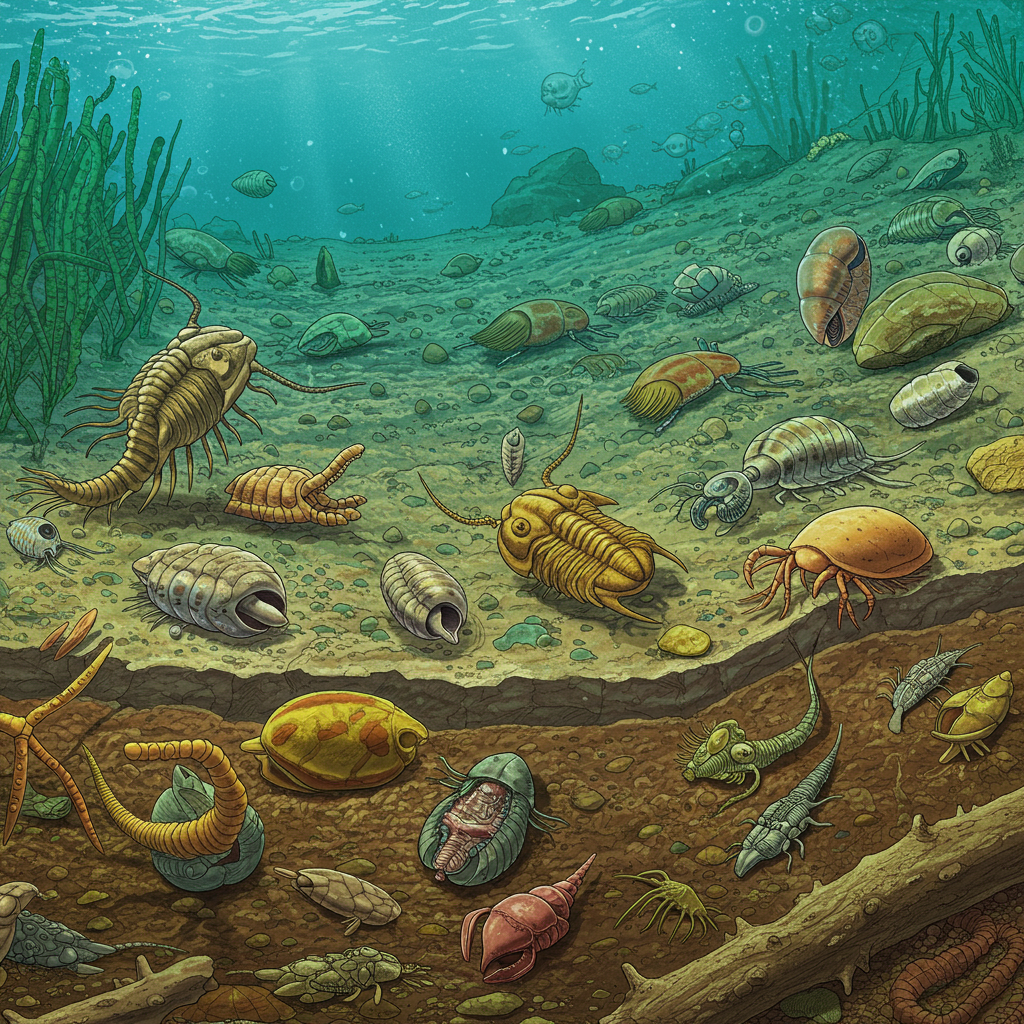Imagine a period when complex animal life seemingly burst onto the scene, filling the oceans with diverse forms. This dramatic era, known as the cambrian Explosion, has long been considered a pivotal “big bang” in Earth’s history, typically dated to around 530 million years ago. It marked the rapid appearance of most modern animal body plans and the first widespread use of hard parts like shells and skeletons.
But what if the fuse for this explosion was lit much earlier? New research is challenging the conventional timeline, pushing the origins of complex, mobile animals back by millions of years. This groundbreaking study suggests that life with sophisticated biological features was already thriving well before the accepted start of the Cambrian period.
Shifting the Timeline of Ancient Life
Published in the journal Geology, this new study presents compelling evidence that complex animal life existed as early as 545 million years ago. This predates the traditional start date of the Cambrian Explosion by a significant 15 million years. Led by researchers Olmo Miguez Salas from the University of Barcelona and Zekun Wang from the Natural History Museum in London, the work focuses on a crucial, often overlooked, type of fossil.
Paleontologists traditionally study the Cambrian period by examining body fossils – the preserved remains of organisms, particularly those with durable hard parts. While these fossils offer invaluable insights, focusing solely on them can create a biased picture. Much of early life, especially during the preceding Ediacaran period, consisted of soft-bodied creatures that rarely fossilize in this way.
trace Fossils: Clues Left Behind
This is where trace fossils become essential. Trace fossils are not the remains of the organism itself, but rather evidence of its activity. These include things like tracks, trails, burrows, and feeding marks left in ancient sediments. For soft-bodied animals that didn’t have shells or bones, trace fossils provide an unparalleled window into their existence, behavior, and interaction with their environment.
The study specifically investigated trace fossils from the Ediacaran-Cambrian boundary. This geological period, spanning roughly 575 to 540 million years ago, represents a major transition. The often enigmatic soft-bodied organisms of the Ediacaran biota gave way to the more familiar, diversified animal groups that characterized the Cambrian. Understanding this transition is key to grasping the origins of modern animal life.
Unlocking Secrets from Ancient Tracks
By carefully analyzing trace fossils dating back to 545 million years ago, Miguez Salas and Wang uncovered surprising details. These ancient marks were not left by simple, sessile (immobile) organisms. Instead, they indicated creatures with a remarkable level of sophistication for their time.
The researchers found evidence suggesting these early animals possessed features like segmented bodies, muscle systems, and importantly, the capability for directional movement. This implies a level of biological complexity far beyond what was previously assumed for life at this age.
The trace fossils hinted at creatures with what scientists call “coelomic hydrostatic bodies.” These are fluid-filled cavities that, when combined with muscles and an anteroposterior (head-to-tail) axis, allow for controlled movement and navigation. The ability to move deliberately, perhaps in response to environmental cues or in search of food, represents a significant evolutionary leap. It suggests the development of basic sensory capabilities and complex neural control much earlier than thought.
Context in Earth’s Evolutionary Story
Placing this finding within the broader sweep of Earth’s history adds perspective. Life spent billions of years evolving from single-celled organisms to simple multicellular forms. The transition to multicellularity itself was a complex process, happening independently in different lineages over vast timescales. Experiments studying the evolution of multicellularity in simple organisms like yeast highlight the challenges involved, such as nutrient diffusion within a group of cells and the need for structural integrity. Overcoming these challenges required significant biological innovation.
The period leading up to and including the Cambrian Explosion was also one of dramatic environmental change on Earth. The planet experienced vast shifts in temperature and atmospheric composition over the last half-billion years. While not the focus of this study, understanding this dynamic environmental backdrop is crucial for appreciating the pressures and opportunities that drove evolutionary developments during this time.
Redefining the “Explosion”
The existence of complex, mobile animals 15 million years before the traditionally accepted start of the Cambrian Explosion fundamentally reshapes our understanding. It suggests that the foundational developments – the evolution of sophisticated body plans, mobility, and behavioral complexity – began much earlier than a sudden “explosion.”
This finding supports the idea that the “evolutionary core” from which most modern animal phyla emerged was developing gradually during the late Ediacaran and earliest Cambrian periods. The Cambrian Explosion might not have been a single, abrupt event, but rather the culmination of a longer period of innovation and diversification. Some scientists refer to earlier pulses of this development as precursors, such as the Fortunian Diversification Event, which immediately precedes the main Cambrian event.
A New Lens for Paleontology
Beyond the specific findings about the Cambrian timeline, the study also introduces a valuable new methodology. The quantitative techniques developed by Miguez Salas and Wang for analyzing trace fossils offer a more precise way to interpret the movements and activities of ancient organisms.
This analytical framework can be applied to trace fossils from other geological periods and locations. It provides scientists with a powerful tool to uncover hidden details about evolutionary transitions, such as the Ordovician Biodiversification Event that followed the Cambrian. By focusing on the subtle clues left behind by soft-bodied creatures, researchers can gain a more complete picture of life’s evolution, even when conventional body fossils are scarce. This new approach promises to yield further insights as more Ediacaran trace fossils are discovered and re-examined using these methods.
Frequently Asked Questions
What are trace fossils and why are they important for understanding early life?
Trace fossils are geological records of biological activity, such as tracks, trails, or burrows, rather than the organism’s body itself. They are crucial for studying early life, especially soft-bodied organisms prevalent in the Ediacaran and early Cambrian periods, because these creatures rarely left behind preserved body fossils. Trace fossils offer unique insights into ancient animals’ behavior, movement, and interaction with their environment.
What specific evidence suggests the Cambrian Explosion started earlier?
New research analyzed trace fossils dating back to 545 million years ago, found at the Ediacaran-Cambrian boundary. These fossils indicate the presence of animals capable of complex, directional movement. Features inferred from the traces, like segmented bodies, muscles, and a head-to-tail axis, suggest a level of biological sophistication (like coelomic hydrostatic bodies and sensory capabilities) existed 15 million years earlier than previously thought, challenging the traditional timeline.
How does this new timeline change our understanding of animal evolution?
This research suggests that the origins of complex animal life and the foundations for the rapid diversification seen in the Cambrian Explosion were laid down millions of years earlier than traditionally accepted. It indicates a more gradual buildup of biological complexity during the late Ediacaran and earliest Cambrian, rather than a sudden, unprecedented burst. This shifts our perspective on when and how the fundamental animal body plans began to emerge.
Conclusion
The discovery of complex trace fossils dating back 545 million years is a significant step in piecing together the puzzle of early animal evolution. It compels us to re-evaluate the timing and nature of the Cambrian Explosion, suggesting that the roots of this pivotal event extend deeper into Earth’s history. By highlighting the value of trace fossils and introducing sophisticated new analytical techniques, this study opens exciting avenues for future research. As scientists continue to explore the ancient past through these subtle yet revealing clues, our understanding of how life on Earth evolved will undoubtedly continue to be refined.




